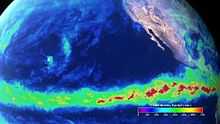Ocean heat content
.png)


Oceanic heat content (OHC) is the heat stored in the ocean. Oceanography and climatology are the science branches which study ocean heat content. Changes in the ocean heat content play an important role in the current sea level rise, because of thermal expansion. It is with high confidence that ocean warming accounts for 90% of the energy accumulation from global warming between 1971 and 2010.[1]
Definition and measurement
Ocean heat content is defined as:[2]

 - water density,
- water density,  - sea water specific heat capacity, h2 - bottom depth, h1 - top depth,
- sea water specific heat capacity, h2 - bottom depth, h1 - top depth,  - temperature profile.
- temperature profile.
OHC is computed from temperature measurements often taken with a Nansen bottle. The ARGO float project deployed 3000 floaters around the world's oceans which periodically dive to take temperature and salinity measurements. The World Ocean Database Project is the largest database for temperature profiles from all of the world’s oceans.
Recent changes
Several studies in recent years have found a multidecadal increase in OHC of the deep and upper ocean regions and attribute the heat uptake to anthropogenic warming.[3] Studies based on ARGO indicate that ocean surface winds, especially the subtropical trade winds in the Pacific Ocean, change ocean heat vertical distribution.[4] This results in changes among ocean currents, and an increase of the subtropical overturning, which is also related to the El Niño and La Niña phenomenon. Depending on stochastic natural variability fluctuations, during La Niña years around 30% more heat from the upper ocean layer is transported into the deeper ocean. Model studies indicate that ocean currents transport more heat into deeper layers during La Niña years, following changes in wind circulation.[5] Years with increased ocean heat uptake have been associated with negative phases of the interdecadal Pacific oscillation (IPO).[6] This is of particular interest to climate scientists who use the data to estimate the ocean heat uptake.
See also
References
- ↑ IPCC AR5 WG1 (2013). PDF "Summary for policymakers".
- ↑ Dijkstra, Henk A. (2008). Dynamical oceanography ([Corr. 2nd print.] ed.). Berlin: Springer Verlag. p. 276. ISBN 9783540763758.
- ↑ Abraham et al. (2013). "A review of global ocean temperature observations: Implications for ocean heat content estimates and climate change". doi:10.1002/rog.20022.
- ↑ Balmaseda, Trenberth & Källén (2013). "Distinctive climate signals in reanalysis of global ocean heat content". doi:10.1002/grl.50382. Essay
- ↑ Meehl et al. (2011). [AbstractDiscussion "Model-based evidence of deep-ocean heat uptake during surface-temperature hiatus periods"]. doi:10.1038/nclimate1229.
- ↑ Rob Painting (2013). "A Looming Climate Shift: Will Ocean Heat Come Back to Haunt us?".